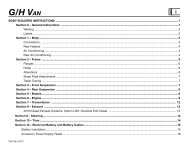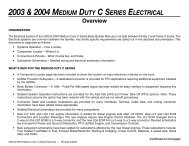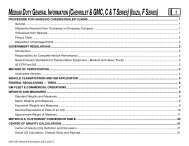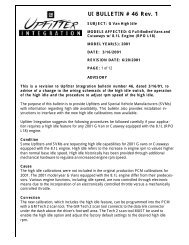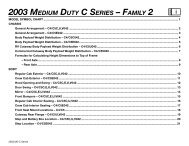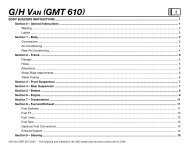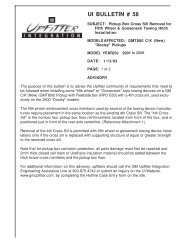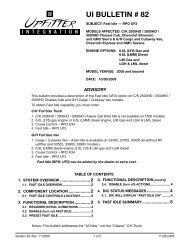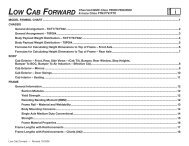s/t small utility – suv (chevy blazer & gmc jimmy) - GM UPFITTER
s/t small utility – suv (chevy blazer & gmc jimmy) - GM UPFITTER
s/t small utility – suv (chevy blazer & gmc jimmy) - GM UPFITTER
Create successful ePaper yourself
Turn your PDF publications into a flip-book with our unique Google optimized e-Paper software.
S/T SMALL UTILITY <strong>–</strong> SUV (CHEVY BLAZER & <strong>GM</strong>C JIMMY)<br />
BODY BUILDERS INSTRUCTIONS.................................................................................................................................................................... 1<br />
Section 0 <strong>–</strong> General Instructions ................................................................................................................................................................1<br />
Section 1 <strong>–</strong> Body...........................................................................................................................................................................................2<br />
Air Conditioning .....................................................................................................................................................................................2<br />
Section 2 <strong>–</strong> Frame ........................................................................................................................................................................................3<br />
Flanges...................................................................................................................................................................................................3<br />
Holes ......................................................................................................................................................................................................3<br />
Welding ..................................................................................................................................................................................................3<br />
Alterations ..............................................................................................................................................................................................4<br />
Shear Plate Attachments.......................................................................................................................................................................4<br />
Section 3 <strong>–</strong> Front Suspension.....................................................................................................................................................................4<br />
Section 4 <strong>–</strong> Rear Suspension......................................................................................................................................................................5<br />
Section 5 <strong>–</strong> Brakes .......................................................................................................................................................................................5<br />
Section 6 <strong>–</strong> Engine........................................................................................................................................................................................6<br />
Section 7 <strong>–</strong> Transmission ............................................................................................................................................................................7<br />
Section 8 <strong>–</strong> Fuel and Exhaust .....................................................................................................................................................................8<br />
Fuel Systems .........................................................................................................................................................................................8<br />
Fuel Lines...............................................................................................................................................................................................8<br />
Fuel Tank................................................................................................................................................................................................9<br />
Exhaust System.....................................................................................................................................................................................9<br />
Section 9 <strong>–</strong> Steering...................................................................................................................................................................................10<br />
Section 10 <strong>–</strong> Tires.......................................................................................................................................................................................11<br />
Section 12 <strong>–</strong> Electrical Battery and Battery Cables...............................................................................................................................11<br />
Accessory Power Supply Feed:..........................................................................................................................................................12<br />
Section 13 <strong>–</strong> Cooling ..................................................................................................................................................................................13<br />
Model Symbol Chart...........................................................................................................................................................................................14<br />
PAGE<br />
i<br />
S/T Small Utility <strong>–</strong> SUV 2004
S/T SMALL UTILITY <strong>–</strong> SUV (CHEVY BLAZER & <strong>GM</strong>C JIMMY)<br />
CHASSIS<br />
GENERAL CHASSIS ARRANGEMENT<br />
2 Door Utility, General Arrangement <strong>–</strong> S/T 10516..........................................................................................................................15<br />
4 Door Utility, General Arrangement <strong>–</strong> S/T 10506..........................................................................................................................16<br />
BODY<br />
EXTERIOR GENERAL ARRANGEMENT<br />
Outside Mirror Options .....................................................................................................................................................................17<br />
S/T Front End Sheet Metal ...............................................................................................................................................................18<br />
UTILITY EXTERIOR<br />
4 Door Utility Exterior <strong>–</strong> S/T 10506 ..................................................................................................................................................19<br />
2 Door Utility Exterior <strong>–</strong> S/T 10516 ..................................................................................................................................................20<br />
2 Door Utility Hi-Wider Exterior <strong>–</strong> S/T 10516 ..................................................................................................................................21<br />
INTERIOR SEATING<br />
2 Door Utility, Interior Seating <strong>–</strong> S/T 10516 ....................................................................................................................................22<br />
4 Door Utility, Interior Seating <strong>–</strong> S/T 10506 ....................................................................................................................................23<br />
FRAME<br />
FRAME RAIL AND CROSSMEMBER ARRANGEMENT<br />
Rail and Crossmember Arrangement <strong>–</strong> S 10506 ...........................................................................................................................24<br />
Rail and Crossmember Arrangement <strong>–</strong> T 10506............................................................................................................................25<br />
Rail and Crossmember Arrangement <strong>–</strong> S 10516 ...........................................................................................................................26<br />
Rail and Crossmember Arrangement <strong>–</strong> T 10516............................................................................................................................27<br />
SPARE TIRE CARRIER<br />
4 Door Utility, Spare Tire Carrier <strong>–</strong> S/T 10506 ................................................................................................................................28<br />
TRAILER HITCH<br />
Utility, Trailer Hitch Mounting <strong>–</strong> S/T 105 (06/16).............................................................................................................................29<br />
PAGE<br />
ii<br />
S/T Small Utility <strong>–</strong> SUV 2004
S/T SMALL UTILITY <strong>–</strong> SUV (CHEVY BLAZER & <strong>GM</strong>C JIMMY)<br />
AXLE/SUSPENSION<br />
Front Axle / Tire Data Chart <strong>–</strong> S 10000....................................................................................................................................................30<br />
Front Axle / Tire Data Chart <strong>–</strong> T 10000 ....................................................................................................................................................31<br />
Utility, Rear Axle / Tire Data Chart <strong>–</strong> S/T 105 (05/16).............................................................................................................................32<br />
FUEL TANK<br />
Fuel Tank <strong>–</strong> S/T 10506................................................................................................................................................................................33<br />
Fuel Tank <strong>–</strong> S/T 10516................................................................................................................................................................................34<br />
EXHAUST<br />
S/T Tail Pipe Locations..............................................................................................................................................................................35<br />
ELECTRICAL<br />
Ordering Information .................................................................................................................................................................................36<br />
PAGE<br />
iii<br />
S/T Small Utility <strong>–</strong> SUV 2004
S/T SMALL UTILITY <strong>–</strong> SUV (CHEVY BLAZER & <strong>GM</strong>C JIMMY)<br />
BODY BUILDERS INSTRUCTIONS<br />
PAGE<br />
1<br />
The Incomplete Vehicle Document (IVD) is supplied with each incomplete vehicle, and provides information that should be used by<br />
intermediate and final stage manufacturers in determining conformity to applicable Federal Motor Vehicle Safety Standards (FMVSS). The<br />
IVD also includes information which must be followed in order to ensure that Environmental Protection Agency (EPA) and California<br />
emissions certification requirements and NHTSA Fuel Regulations are met.<br />
The Body Builders Manual contains information that may be used in addition to the IVD for any manufacturer making alterations to a <strong>GM</strong><br />
complete/incomplete vehicle. No alteration should be made to the incomplete vehicle which either directly or indirectly results in any<br />
component, assembly or system being in nonconformance with any applicable Federal Motor Vehicle Safety Standard or Emission<br />
Regulation. Intermediate and final stage manufacturers should be familiar with all Federal Motor Vehicle Safety Standards and Emission<br />
Regulations and aware of their specific responsibilities as manufacturers.<br />
For further assistance contact Upfitter Integration at: 1 (800) 875-4742, or go to our Web site at “http://www.gmupfitter.com.”<br />
Section 0 — General Instructions<br />
Check for proper clearance between body members and chassis components which may in any way affect the reliability and performance<br />
of the vehicle by developing abrasion and wear points from moving parts or degradation from extreme environment or thermal exposure or<br />
may increase interior noise.<br />
Check headlamp aim and all vehicle illumination systems for proper operation when the vehicle has been completed. Re-aim headlamps<br />
when necessary. Check for proper operation of windshield washer, wipers and defroster system.<br />
Extreme care must be taken when working on vehicles equipped with Powertrain Control Module (PCM), Vehicle Control Module (VCM) or<br />
any electronic unit associated with an inflatable restraint system. (See Owner’s Manual).<br />
If arc-welding is employed on the chassis, precautions must be taken to protect all vehicle components, especially brake, fuel lines and fuel<br />
tank assembly, electrical wiring and ECM/PCM/TCM or VCM. To avoid electronic component damage, disconnect battery (batteries);<br />
disconnect the negative cable first, followed by the positive. To reconnect cables; connect the positive first, then the negative.<br />
When welding components to the frame assembly, remove the wax coating in the area of the weld in order to obtain secure welds. After<br />
completion of the weld, a compatible corrosion protection should be applied to the affected weld areas.<br />
All labels on the vehicle (any message applied to the vehicle or vehicle component that informs, instructs, or warns) must appear on the<br />
completed vehicle so the user can read them easily and without obstruction.<br />
S/T Small Utility <strong>–</strong> SUV 2004<br />
(Section 0 — continued on next page)
S/T SMALL UTILITY <strong>–</strong> SUV (CHEVY BLAZER & <strong>GM</strong>C JIMMY)<br />
(Section 0 — continued from previous page)<br />
Service and service replacement parts for your add-on systems may not be available from a <strong>GM</strong> dealer. Those installing aftermarket systems<br />
should provide information as to where and how to obtain service.<br />
Section 1 — Body<br />
Body structures, interior and accessory arrangements must be designed into the vehicle to provide for proper load distribution on both axles<br />
and not to exceed any gross axle weight ratings. Lateral load equalization must also be maintained. The resultant Center of Gravity of the<br />
unladen vehicle must be within the limits tabulated in the FMVSS 105 section of the Incomplete Vehicle Document.<br />
Body insulation provided by General Motors should not be removed. This includes any thermal or underbody heat shields. This insulation is<br />
provided to protect the vehicle body and occupants from excessive heat and/or provide noise attenuation. Any replacement material internal<br />
to the occupant compartment must be certified for MVSS standard on flammability. Areas of specific concern, but not limited to, are:<br />
• Underbody exhaust, muffler and tail pipe shields and insulators.<br />
• Rear load floor interior insulation.<br />
• Front floor interior insulation.<br />
• Dash mat insulation.<br />
• Engine cowl insulation <strong>–</strong> interior and exterior.<br />
• Engine cover insulation.<br />
If body builder installs seating other than that supplied with vehicle, it is the body builder’s responsibility to ensure that the seating and<br />
restraint systems comply with FMVSS requirements. The restraint systems supplied with the vehicle were designed to accommodate the<br />
seating reference points and seat travel of the original equipment seats only.<br />
Air Conditioning<br />
For additional information refer to Engine <strong>–</strong> Section 6.<br />
NOTE: Air conditioning systems using R-134A refrigerant are equipped with metric fittings to prevent interchange with R-12 refrigerant<br />
components. Do not interchange R-134A components, refrigerant oil or service equipment with R-12 components, refrigerant oil or<br />
service equipment.<br />
PAGE<br />
2<br />
S/T Small Utility <strong>–</strong> SUV 2004
S/T SMALL UTILITY <strong>–</strong> SUV (CHEVY BLAZER & <strong>GM</strong>C JIMMY)<br />
Section 2 — Frame<br />
PAGE<br />
3<br />
Hole drilling, welding, modifications, or alterations to the frame assembly are the responsibility of persons performing these operations.<br />
These same individuals assume complete responsibility for frame assembly reliability, performance after alterations and compliance to<br />
applicable FMVSS requirements.<br />
The following procedures and specific precautionary instructions are recommended for proper installation of special bodies and/or<br />
equipment on <strong>GM</strong> frames. Failure to follow these recommendations could result in serious damage to the basic vehicle.<br />
Flanges<br />
Do not drill holes in frame flanges.<br />
Holes<br />
Holes to mount brackets, supports, and out-riggers must be drilled in the vertical side rail web with the following restrictions:<br />
• Material between edge of hole and inside of upper or lower flange must not be less than 37 mm (1.50 in.) for low carbon steel<br />
(36,000 PSI yield).<br />
• The minimum edge distance between any two (2) holes must be larger than twice the diameter of the larger hole.<br />
• No holes should exceed 20 mm (0.75 in.) in diameter.<br />
• All holes should be drilled in the frame using appropriate drilling practice and safety precautions.<br />
Welding<br />
CAUTION: Fuel tank and fuel lines must be drained and all vapors purged to ensure noncombustible mixture before any welding, brazing<br />
or soldering.<br />
When welding low carbon steel side rails, crossmembers and brackets (32,000 or 36,000 PSI yield strength), emphasis is placed upon weld<br />
application techniques to avoid stress risers that may adversely affect frame operating stresses.<br />
When welding is performed anywhere on the vehicle, precautionary measures should be taken to prevent damage to electrical system wiring<br />
or components. Prior to any welding, parts or components which could be damaged by excessive temperatures must be removed or<br />
adequately shielded; the battery cables should be disconnected at the battery. Also prior to welding, the area to be welded and surrounding<br />
area must be cleaned of all frame protective coating. After welding, when parts are cool, carefully inspect wiring and electrical components<br />
S/T Small Utility <strong>–</strong> SUV 2004<br />
(Section 2 — continued on next page)
S/T SMALL UTILITY <strong>–</strong> SUV (CHEVY BLAZER & <strong>GM</strong>C JIMMY)<br />
(Section 2 — continued from previous page)<br />
for shorts or other damage which could draw excessive currents and possibly cause an electrical system short when the battery is<br />
reconnected. Apply protective coating to areas where coating was removed.<br />
Alterations<br />
If the wheelbase is modified the alterer must take responsibility for compliance with affected motor vehicle safety standards and for warranty<br />
on items such as driveshafts, universal joints, center bearings and rear transmission tailshaft, transfer case and transmission case fractures,<br />
output shaft bushings, bearings, brakes, fuel systems and any other related component failures. Additionally, the customer must be alerted<br />
in the modifier’s owner’s manual that parts for the reworked area are not available through the General Motors service parts system.<br />
Shear Plate Attachments<br />
Attachments of shear plates should be accomplished by using existing manufacturing holes already available in the frame side rails. Manufacturing<br />
holes, normally 16 mm in diameter, are consistently placed along the frame side member in the center of the web on each frame.<br />
When additional holes are required for shear plate attachment, they should be no larger than 20 mm (0.75 in.) in diameter. Holes are to be<br />
drilled no closer than 63.5 mm (2.5 in.) apart. For holes drilled forward of the rear axle, centers are to be no closer than 63.5 mm (2.5 in.)<br />
from the top or bottom flanges and no closer than 89 mm (3.5 in.) from any suspension attachments. For frame holes drilled rearward of the<br />
rear axle, hole centers are to be no closer than 51 mm (2.0 in.) from the top or bottom flange and no closer than 89 mm (3.5 in.) from<br />
suspension attachments.<br />
No additional holes or notching of either top or bottom frame flanges is allowed.<br />
Rear bodies or platforms added to the vehicle must utilize the released attachment points used by the pick-up box, along with<br />
fasteners of the same diameter. These are minimum requirements; additional fasteners are permissible.<br />
Section 3 — Front Suspension<br />
See chassis data information for clearances and assistance in calculating trim heights.<br />
Since there is a large variation in completed vehicle front weight due to differences in body weight and equipment, the front suspension<br />
alignment must be checked and reset if necessary after the vehicle is completed. Caster and camber should be set with reference to the<br />
“A” dimensions.<br />
See Truck Service Manual for complete alignment procedure, specifications and measurement of the “A” dimension under “Diagnosis and<br />
Front Alignment” section.<br />
S/T Small Utility <strong>–</strong> SUV 2004<br />
PAGE<br />
4
S/T SMALL UTILITY <strong>–</strong> SUV (CHEVY BLAZER & <strong>GM</strong>C JIMMY)<br />
Section 4 — Rear Suspension<br />
PAGE<br />
5<br />
Clearance to body should be provided for the suspension, axle, driveshaft and tires under the following conditions: (1) Axle in full jounce<br />
against the metal-to-metal stop, (2) Axle at 4.5˚ roll with one side of axle in full jounce at the metal-to-metal stop and (3) Axle at design<br />
position. Allowance for the tire chain clearance shown on a maximum grown tire must allow for (1.66 in.) clearance to the sides of the tire<br />
and (2.5 in.) to the top of the tire. Be sure sufficient clearance is provided for suspension, axle and tire and wheel in full vertical travel (up<br />
and down).<br />
NOTE: Notification to the consumer may be required in certain states if tire chains cannot be used.<br />
Pipes, wiring, conduits and any other related components must not be placed where they cross the path of motion of the rear axle, driveshaft,<br />
axle brake pipes, hoses, spring or tires. Such crossing could result in rupture, wear through, or separation due to normal axle motion.<br />
See chassis data information for additional clearances and for assistance in calculating trim heights.<br />
See Truck Service Manual for brake specifications.<br />
Section 5 — Brakes<br />
Due to the critical nature of brake systems, anyone making modifications or alterations must assume complete responsibility for<br />
system reliability, performance and certification to FMVSS 105 or FMVSS 121.<br />
It is mandatory that no change be made to the brake main cylinder location, brake pedal push rod length or pedal position.<br />
Ensure that hydraulic brake system is free of air and hydraulic leaks. Bleed brakes if required, following procedures as outlined in truck<br />
chassis service manual. Ensure that vacuum booster system or hydroboost system is functional and free of leaks.<br />
Check master cylinder fluid level and fill as necessary. (Refer to Owner’s Manual).<br />
Check power steering fluid level for models equipped with hydroboost brake. (Refer to Owner’s Manual).<br />
Added floor covering or carpeting must not restrict service or parking brake pedal travel from released position to full pedal travel.<br />
No body part or chassis-mounted component may be located within 2.0 in. of brake hose routing in all wheel and axle positions. All exhaust<br />
system components must also have a minimum of 2.0 in. clearance to brake hoses in closest positions. (Be sure to account for brake hose<br />
travel with suspension).<br />
S/T Small Utility <strong>–</strong> SUV 2004<br />
(Section 5 — continued on next page)
S/T SMALL UTILITY <strong>–</strong> SUV (CHEVY BLAZER & <strong>GM</strong>C JIMMY)<br />
(Section 5 — continued from previous page)<br />
Body builder is to verify that the brake warning switch is operative. The brake warning switch on models equipped with vacuum-hydraulic<br />
brakes is located adjacent to the master cylinder vacuum unit. This includes both the brake system differential pressure and parking brake<br />
actuator switch.<br />
For additional information refer to Body - Section 1.<br />
Section 6 — Engine<br />
Air conditioning and auxiliary belt-driven equipment installation recommendations:<br />
No alterations or additions to the accessory drive belt system will be warranted on serpentine belt systems.<br />
The serpentine belt type of drive is designed as a total system, incorporating a single poly-V belt and an automatic tensioner. In this type of<br />
system, degrees of pulley wrap, belt tension, and pulley alignment are very critical factors. Modification is not recommended.<br />
In some single belt serpentine systems, belt tension is determined by the automatic tensioner and its position relative to the belt. No<br />
adjustment is required.<br />
Due to the critical nature of the accelerator system, anyone making modifications or alterations assumes complete responsibility for system<br />
reliability, performance and compliance to FMVSS 124. Caution must be exercised so that the accelerator cable is properly routed.<br />
Specifications are as follows:<br />
• Route cable to maximize all bend radii. In no case should bend radii be less than 3 in. (76 mm).<br />
• Minimum distance from exhaust manifold to be 6.0 in. (150 mm), unless a heat shield is provided.<br />
• Do not use accelerator cable or clips to route wires, harnesses or other cables. Cable sheath must be clipped so as not to pinch<br />
inner cable. Cable must not be loose in clip allowing sheath to move when accelerator pedal is applied and released.<br />
• Cable must not be subjected to kinking or routing across any sharp edges.<br />
• Cable routing must be perpendicular to the surface of the front-of-dash at the dash fitting. No objects or routings should force<br />
cable to have a bend at the dash fitting. Flexible components (hoses, wires, conduits, etc.) must not be routed within 2.0 in.<br />
(50 mm) of moving parts or accelerator linkage unless routing is positively controlled.<br />
PAGE<br />
6<br />
S/T Small Utility <strong>–</strong> SUV 2004<br />
(Section 6 — continued on next page)
S/T SMALL UTILITY <strong>–</strong> SUV (CHEVY BLAZER & <strong>GM</strong>C JIMMY)<br />
(Section 6 — continued from previous page)<br />
• Caution must be taken so that the accelerator pedal remains properly located. Guidelines for accelerator pedal locations are as<br />
follows:<br />
— Ensure that the accelerator can freely operate from idle to wide-open throttle position and return. Make sure that the pedal will<br />
not hang up on any nearby items such as carpets, floor, screws, wiring harnesses, etc. Engine cover should have at least one<br />
inch (25 mm) clearance to side of accelerator pedal with the carpet mat installed.<br />
— Accelerator to brake pedal relationship has been designed to provide minimum driver movement and should not be altered in<br />
any way.<br />
Gasoline engine induction and/or ignition system is certified in compliance with the Federal Vehicle Emission Standards. Any alterations to<br />
the systems or components could void compliance and render the vehicle illegal. System includes:<br />
• Fuel system <strong>–</strong> throttle body and port fuel injection (PFI) or sequential central port injector (SCPI) and associated tubes, hoses and<br />
pipes, air cleaner outside air hose, mass air flow sensor, fuel pump and inlet manifold, fuel vapor canister.<br />
• Exhaust system.<br />
• Ignition system distributor and initial spark timing setting, spark plugs, spark plug wires.<br />
• Crankcase ventilation system.<br />
Section 7 — Transmission<br />
Light duty models equipped with manual transmission have a clutch-operated start safety switch. Starter should operate whenever the<br />
ignition is turned to start and the clutch is fully depressed. Readjust if necessary as outlined in the Truck Service Manual.<br />
Models equipped with automatic transmissions have a steering column mounted or a transmission mounted neutral/park start safety<br />
mechanical lockout feature, which interfaces with the steering column ignition switch. Starter should operate only when gear shift lever is in<br />
neutral or park position. Readjust the shift linkage or neutral start backup switch if necessary as outlined in the Truck Service Manual.<br />
Models equipped with manual transmission use a hydraulic clutch actuator. Check fluid level as outlined in the vehicle owner’s manual.<br />
It is mandatory that no change be made to the clutch master cylinder location, clutch master or slave cylinder push rod length, or pedal<br />
position.<br />
PAGE<br />
7<br />
S/T Small Utility <strong>–</strong> SUV 2004
S/T SMALL UTILITY <strong>–</strong> SUV (CHEVY BLAZER & <strong>GM</strong>C JIMMY)<br />
Fuel Systems<br />
Section 8 — Fuel and Exhaust<br />
PAGE<br />
8<br />
Due to the critical nature of sealing the fuel system, anyone making modifications or alterations to the existing system must assume<br />
complete responsibility for the system reliability, performance and compliance to FMVSS 301.<br />
The fuel evaporative emission control equipment is certified to be in compliance with the Federal and California Vehicle Emission Standards.<br />
Any alterations to systems or components and their location could void compliance. System includes:<br />
• Fuel tank, metering unit, lines including purge control solenoids and canister or canisters.<br />
For these reasons, NO ALTERATION OF THE FUEL SYSTEM IS RECOMMENDED.<br />
Fuel Lines<br />
Fuel line routing precautions:<br />
• 12 in. minimum clearance to exhaust system is required or a metal shield must be provided.<br />
• Fuel lines should be clipped to chassis to prevent chafing. Metal clips must have rubber or plastic liners.<br />
• Use corrosion resistant steel tubing with short sections of approved hose to connect components. Hose-to-tube connections<br />
should be clamped for diesel systems. Steel tube ends should be beaded for hose retention. Fuel supply is pressurized by an<br />
in-tank pump for PFI and SCPI systems. Coupled hose or nylon quick-connects must be used. Clamped hose is not acceptable<br />
for PFI and SCPI systems.<br />
All engines require a fuel return system which returns excess fuel from the injection pump and injector nozzles back to fuel tanks. Care should<br />
be taken that these lines are not blocked nor their hoses pinched. The engine may run poorly or stall if these lines are restricted or blocked.<br />
All gasoline engine vehicles are equipped with fuel evaporative emission control equipment which is certified to be in compliance with the<br />
Federal or applicable California vehicle emission standards. Alterations to fuel tank and metering unit, lines, canister or canisters, canister<br />
filters, canister purge control valves, relay switches, tank auxiliary vent valve, engine speed controller, or other devices/systems are therefore<br />
not allowable since vehicle adherence to C.A.R.B. and Federal regulations may be affected.<br />
Diesel powered vehicles incorporate water drain provisions in the fuel system. These valves are only to be opened when siphoning water<br />
and contaminants from the fuel system.<br />
S/T Small Utility <strong>–</strong> SUV 2004<br />
(Section 8 — continued on next page)
S/T SMALL UTILITY <strong>–</strong> SUV (CHEVY BLAZER & <strong>GM</strong>C JIMMY)<br />
(Section 8 — continued from previous page)<br />
Fuel Tank<br />
PAGE<br />
9<br />
For vehicles with full frames, the tank must have a minimum clearance of 2 in. top, front, rear and sides to body and other supports.<br />
Tank may be pressurized to 1.25 PSI maximum to check for final line leakage or for forcing fuel through the system. Pressures greater than<br />
this amount may be detrimental and affect tank durability.<br />
The use of auxiliary fuel tanks is not recommended. If an auxiliary fuel tank is added, the alterer must take responsibility for compliance<br />
with affected motor vehicle safety standards. Also, if an auxiliary fuel tank is added to a gasoline-powered vehicle, the fuel must be drawn<br />
through a pipe at the top of the tank (balance line between tanks is not permitted).<br />
Gasoline fueled vehicles are now equipped with a fuel pump return line. If an auxiliary tank is added, the tank selector valve must include a<br />
return port which returns fuel to the tank from which the fuel is being drawn.<br />
In gasoline engines the fuel pump is located in the fuel tank. The battery must be disconnected before starting any work on the fuel system.<br />
In the use of dual fuel systems, the vehicle operator should strictly adhere to the manufacturer’s procedures for switching from gasoline to<br />
gaseous fuel operation. Improper switching procedures may result in overheating and damage to the exhaust system and the vehicle. The<br />
gaseous fuel tank should not be mounted in an enclosed area of the vehicle, such as the passenger compartment, trunk, etc., and the<br />
system should be vented to the outside of the vehicle. In addition, vehicles converted to gaseous fuels should not be stored in enclosed<br />
places such as garages. Further, General Motors cautions purchasers that the design, location and installation of any type of fuel storage<br />
system involves significant technical and engineering considerations and that these statements on gaseous fuel conversions should not be<br />
interpreted to be an approval by General Motors of any modification to the original equipment fuel system.<br />
Conversions to gaseous fuel should be made in conformance with applicable Federal and State regulations. Removal of emission-control<br />
components, or the addition of gaseous fuel systems which could damage or reduce the longevity of those components and could also<br />
cause the mechanical and emission performance warranty to be voided.<br />
Exhaust System<br />
Particular care should be taken to prevent the possibility of exhaust fumes and carbon monoxide exposure to vehicle occupants in units<br />
completed by body builders. Holes and openings through the floor and alI other parts of the body must be permanently and adequately<br />
sealed by the body builder to avoid exhaust intrusion into any occupant area. If it is necessary to change the exhaust outlet location, the<br />
exhaust discharge must be unobstructed and directed away from occupant areas. Alteration of the exhaust outlet or its position may<br />
increase exhaust noise and render the vehicle illegal in those areas with pass-by noise regulations. All vehicles > 10,000 lbs. GVWR come<br />
under Federal noise regulations, vehicles: < 10,000 lbs. GVWR are regulated by various state and local regulations of the Environmental<br />
Protection Agency; see those regulations for rules, test procedure and noise levels permitted.<br />
(Section 8 — continued on next page)<br />
S/T Small Utility <strong>–</strong> SUV 2004
S/T SMALL UTILITY <strong>–</strong> SUV (CHEVY BLAZER & <strong>GM</strong>C JIMMY)<br />
(Section 8 — continued from previous page)<br />
Tail pipe outlet location must be tested statically and with the vehicle in motion to ensure that exhaust gases do not penetrate side or rear<br />
windows or underbody seams and holes. Auxiliary power plants should also be tested under the same conditions. Tail pipe exit ahead of<br />
rear wheels is not recommended.<br />
Check for leaks in exhaust systems and repair as required.<br />
Any exhaust joint which has been disassembled must have the exhaust gasket replaced and the fasteners torqued to specifications.<br />
Re-check exhaust system for leaks.<br />
Exhaust temperatures can exceed 1600ºF under extreme operating conditions, with pipe surface temperatures slightly less than this.<br />
Extreme care must be used when placing body components in the proximity of the exhaust system so as not to exceed the rated<br />
temperature limits of the components. Due to variants in underbody configurations of the vehicles, we are not in a position to make<br />
recommendations on how to insulate or design components in the proximity of the exhaust system.<br />
Each manufacturer must make temperature checks of critical areas of his vehicle and adjust his design accordingly, or provide shielding to<br />
ensure safe operation of his body components.<br />
The same can be said for the engine compartment. Obviously there will be additional heat radiated from the engine. How much is retained<br />
in the area will depend on how well this area is ventilated in your individual designs. Here again, temperature checks of interior areas<br />
surrounding the engine should be made to determine if your insulation is adequate. This is the same engineering practice we have followed<br />
on our complete vehicles incorporating these exhaust systems.<br />
Exhaust system materials are selected and tested to withstand the operating environment of the vehicle. Do not modify the exhaust system<br />
in any way. The tail pipes are made of 409 aluminized stainless steel.<br />
Heatshields are mounted to the underbody and/or exhaust system components (catalytic converter, muffler and tail pipe). Shields for the<br />
propshaft hanger bearings are also provided in some vehicles.<br />
Section 9 — Steering<br />
Check power steering fluid level and system operations. (Refer to Owner’s Manual).<br />
The power steering hydraulic system should not be used to drive any other accessories.<br />
Steering wheel and horn pad must not be altered or replaced.<br />
The steering column mast jacket must not be altered.<br />
S/T Small Utility <strong>–</strong> SUV 2004<br />
PAGE<br />
10
S/T SMALL UTILITY <strong>–</strong> SUV (CHEVY BLAZER & <strong>GM</strong>C JIMMY)<br />
Section 10 — Tires<br />
Check wheel lug nuts for proper torque; specifications are provided in the Owner’s Manual.<br />
PAGE<br />
11<br />
Substitution of tires of greater capacity than those offered as original equipment by vehicle manufacturer is not approved for use on original<br />
equipment wheels. Any usage of higher capacity tires must be accompanied by higher capacity wheels. However, the wheel offset and<br />
distance from centerline of rim to wheel mounting face must be the same as the replaced original equipment wheel to ensure proper wheel<br />
bearing loading and clearance of tires to body and chassis components.<br />
Increasing tire and wheel capacity does not necessarily increase vehicle GVW ratings. It is recommended that tire chain clearance guideline,<br />
J683, from the Society of Automotive Engineers be adhered to in designing rear wheelhouse clearance.<br />
Check tires and inflate to recommended tire pressure according to the tire pressure information provided in Owner’s Manual and tire inflation<br />
label provided with vehicle.<br />
Any substitution of tires may affect Speedometer/Odometer accuracy.<br />
Section 12 — Electrical Battery and Battery Cables<br />
The vehicle battery should be located and positioned to make use of the existing battery cables. If the battery requires relocation and longer<br />
cables are required, a proportionately larger gauge wire must be used. If in relocating the battery the negative ground cable is attached to<br />
frame rail, a cable of similar gauge be provided between the frame rail and the engine. This is required due to the heavy electrical loads<br />
imposed by the starting circuit. To ensure proper operation of the battery cables the following chart on length, gauge and materials must be<br />
strictly adhered to:<br />
Cable Gauge<br />
4<br />
2<br />
0<br />
Combined length of positive and negative<br />
Cable in Inches (Copper)<br />
66<br />
107<br />
170<br />
If the battery is remotely mounted (other than in the engine compartment) the ‘sense’ circuit in the generator regulator shall be used. The<br />
sense circuit consists of a 7.76 OHM 1/4 watt resistor connected in series between the ‘S’ terminal of the generator and the B+ terminal of<br />
the battery.<br />
S/T Small Utility <strong>–</strong> SUV 2004 <strong>–</strong> Revised 06/2009<br />
(Section 12 — continued on next page)
S/T SMALL UTILITY <strong>–</strong> SUV (CHEVY BLAZER & <strong>GM</strong>C JIMMY)<br />
(Section 12 — continued from previous page)<br />
Modifications/add-on wiring must be carefully reviewed to ensure compatibility with the base vehicle wiring by reviewing system schematics,<br />
wire routing paths, harness connections, etc. Due to the wide range of modifications that may be required for vocational needs, it is not<br />
feasible for the O.E.M. to take into account all potential revisions. For this reason, any person modifying existing vehicle wiring must assume<br />
responsibility that the revisions have not degraded the electrical system performance. Any add-on wiring must be properly fused and routed<br />
to prevent cut, pinch, and chafe problems, as well as avoid exposure to excessive heat. Care must be exercised that existing vehicle<br />
interfaces do not have their current load capabilities exceeded, and that the respective control devices are not overloaded. Added wire size<br />
should be at least as large as the wire to which it is attaching in order for fuse protection to be maintained.<br />
A Packard electric wiring repair kit is available through Kent-Moore (<strong>GM</strong> P/N 12085264, Kent-Moore P/N J38125-4). This kit contains<br />
instructions, tools and components for making repairs to wiring harness components. This kit would also greatly assist in accomplishing<br />
necessary add-on wiring such as body marker lamps, so that system reliability/durability is maintained.<br />
Electrical wiring components can be obtained through your authorized <strong>GM</strong> dealer. Many Packard Electric components are also available<br />
through Pioneer Standard Company (1 800-PACKARD). Pioneer may also be able to assist in making necessary wiring additions by providing<br />
custom wiring stubs or jumpers to your specifications.<br />
Fusible Link Repair Procedure:<br />
1. Cut damaged fusible link from wiring harness assembly splice.<br />
2. Strip insulation from harness wire as required to splice on new fusible link.<br />
3. Fabricate a new fusible link wire approximately 6 to 8 in. long from the same wire size as the original link. (Acceptable fusible link<br />
material will be imprinted with the wire size and the wording to identify it as fusible link. Fusible link cable is not the same as normal<br />
vehicle wiring.)<br />
4. Terminate fusible link harness wire with a suitable compression splice clip, and solder with an electrical grade rosin core solder.<br />
Wrap splice area with tape to provide electrical insulation, as well as mechanical strain relief at the splice.<br />
5. Strip, terminate, solder, and insulate remaining end of fusible link with appropriate termination to be compatible with the rest of<br />
the electrical system.<br />
6. For further information, refer to the instruction manual in the wiring repair kit referenced elsewhere in this section.<br />
Accessory Power Supply Feed:<br />
For power requirements to service additional devices to be added by body builder/upfitter, the power supply source must be at the junction<br />
block on the front of dash above battery using the <strong>small</strong> on the left-hand side of junction block.<br />
NOTE: A ground stud has also been provided above the junction block.<br />
S/T Small Utility <strong>–</strong> SUV 2004<br />
PAGE<br />
12
S/T SMALL UTILITY <strong>–</strong> SUV (CHEVY BLAZER & <strong>GM</strong>C JIMMY)<br />
Section 13 — Cooling<br />
To provide satisfactory engine cooling, the following conditions must be met:<br />
PAGE<br />
13<br />
1. Do not locate any large objects in front of the radiator core or grille such as batteries, spare tires, lights/sirens, etc. They restrict<br />
air flow into the radiator core and influence fan blade stress.<br />
2. Grille opening, size configuration and the external baffles provided should not be altered in any manner. Any reduction in cooling<br />
ability may adversely affect engine/transmission performance.<br />
3. Fan clutches not conforming to the original equipment specifications may not operate correctly and may stay “on” continuously,<br />
never come on, or cycle on and off excessively. This will result in a reduction of fuel economy, engine overheat at times, and<br />
annoying cycling respectively.<br />
4. Continuous coolant flow is necessary from heater connection on engine-to-heater connection on radiator to control transmission<br />
oil temperatures during closed thermostat (warm-up) operation. Do not alter this flow as it may result in premature engine or<br />
transmission failure.<br />
5. If a heater unit is not installed in the vehicle or a heater shut-off-valve is required, a line connecting the heater connection on the<br />
engine to the heater connection on the radiator must be installed. When a shut-off valve is required in heating system, it must be<br />
teed into the system in such a manner as to maintain continuous flow between engine heater connection-radiator heater<br />
connection at all times.<br />
6. Use <strong>GM</strong> 6277M Long Life Coolant only.<br />
Do not install any internal flow restrictors.<br />
• Heater hose: 3-way or 4-way valves must be used to provide constant water flow through the intake manifold pad area.<br />
• If in-line shut-off valve is used in combination with 3-way valves, shut-off valve must not be closed until 3-way valve at engine is<br />
in the proper position.<br />
Valve Sources<br />
Red-White Valve Corp., Carson, CA (213) 549-1010<br />
3<br />
Ranco Controls Div., Delaware, OH (614) 876-8022<br />
4 Ranco Controls Div., Delaware, OH (614) 876-8022<br />
Be sure to add coolant to system after adding capacity to system (heaters).<br />
S/T Small Utility <strong>–</strong> SUV 2004
S/T SMALL UTILITY <strong>–</strong> SUV (CHEVY BLAZER & <strong>GM</strong>C JIMMY)<br />
Model Symbol Chart<br />
PAGE<br />
14<br />
TRUCK (Optional)<br />
ENGINEERING<br />
MODEL<br />
MODEL / MODEL / MODEL / MODEL /<br />
MERCHANDISING MERCHANDISING MERCHANDISING MERCHANDISING<br />
DESCRIPTION DESCRIPTION DESCRIPTION DESCRIPTION<br />
GVWR WHEELBASE CAB-TO-AXLE<br />
(kg/lbs) (mm/in) (mm/in)<br />
16 With<br />
S10516 2018/4450 2553/100.5<br />
E55 Endgate<br />
16 With 2220/4850<br />
T10516 2553/100.5<br />
E55 Endgate 2267/5000<br />
16 With<br />
S10506 2267/5000 2718/107<br />
E55 Endgate<br />
16 With<br />
T10506 2426/5350 2718/107<br />
E55 Endgate<br />
S/T Small Utility <strong>–</strong> SUV 2004
S/T SMALL UTILITY <strong>–</strong> SUV (CHEVY BLAZER & <strong>GM</strong>C JIMMY)<br />
S/T 10516 — 2 Door Utility, General Arrangement<br />
PAGE<br />
15<br />
TD005626<br />
S/T Small Utility <strong>–</strong> SUV 2004
S/T SMALL UTILITY <strong>–</strong> SUV (CHEVY BLAZER & <strong>GM</strong>C JIMMY)<br />
S/T 10506 <strong>–</strong> 4 Door Utility, General Arrangement<br />
PAGE<br />
16<br />
TD005626<br />
S/T Small Utility <strong>–</strong> SUV 2004
S/T SMALL UTILITY <strong>–</strong> SUV (CHEVY BLAZER & <strong>GM</strong>C JIMMY)<br />
Outside Mirror Options<br />
PAGE<br />
17<br />
TD005723<br />
S/T Small Utility <strong>–</strong> SUV 2004
S/T SMALL UTILITY <strong>–</strong> SUV (CHEVY BLAZER & <strong>GM</strong>C JIMMY)<br />
S/T Front End Sheet Metal<br />
PAGE<br />
18<br />
TD005720<br />
S/T Small Utility <strong>–</strong> SUV 2004
S/T SMALL UTILITY <strong>–</strong> SUV (CHEVY BLAZER & <strong>GM</strong>C JIMMY)<br />
S/T 10506 4 Door Utility Exterior<br />
PAGE<br />
19<br />
TD005630<br />
S/T Small Utility <strong>–</strong> SUV 2004
S/T SMALL UTILITY <strong>–</strong> SUV (CHEVY BLAZER & <strong>GM</strong>C JIMMY)<br />
S/T 10516 2 Door Utility Exterior<br />
PAGE<br />
20<br />
TD005629<br />
S/T Small Utility <strong>–</strong> SUV 2004
S/T SMALL UTILITY <strong>–</strong> SUV (CHEVY BLAZER & <strong>GM</strong>C JIMMY)<br />
S/T 10516 2 Door Utility Hi-Wider Exterior<br />
PAGE<br />
21<br />
TD005636<br />
S/T Small Utility <strong>–</strong> SUV 2004
S/T SMALL UTILITY <strong>–</strong> SUV (CHEVY BLAZER & <strong>GM</strong>C JIMMY)<br />
S/T 10516 <strong>–</strong> 2 Door Utility, Interior Seating<br />
PAGE<br />
22<br />
TD000000<br />
S/T Small Utility <strong>–</strong> SUV 2004
S/T SMALL UTILITY <strong>–</strong> SUV (CHEVY BLAZER & <strong>GM</strong>C JIMMY)<br />
S/T 10506 <strong>–</strong> 4 Door Utility, Interior Seating<br />
PAGE<br />
23<br />
TD000000<br />
S/T Small Utility <strong>–</strong> SUV 2004
S/T SMALL UTILITY <strong>–</strong> SUV (CHEVY BLAZER & <strong>GM</strong>C JIMMY)<br />
S 10506 Rail and Crossmember Arrangement<br />
PAGE<br />
24<br />
TD005626<br />
S/T Small Utility <strong>–</strong> SUV 2004
S/T SMALL UTILITY <strong>–</strong> SUV (CHEVY BLAZER & <strong>GM</strong>C JIMMY)<br />
T 10506 Rail and Crossmember Arrangement<br />
PAGE<br />
25<br />
TD005626<br />
S/T Small Utility <strong>–</strong> SUV 2004
S/T SMALL UTILITY <strong>–</strong> SUV (CHEVY BLAZER & <strong>GM</strong>C JIMMY)<br />
S 10516 Rail and Crossmember Arrangement<br />
PAGE<br />
26<br />
TD005960d<br />
S/T Small Utility <strong>–</strong> SUV 2004
S/T SMALL UTILITY <strong>–</strong> SUV (CHEVY BLAZER & <strong>GM</strong>C JIMMY)<br />
T 10516 Rail and Crossmember Arrangement<br />
PAGE<br />
27<br />
TD005960c<br />
S/T Small Utility <strong>–</strong> SUV 2004
S/T SMALL UTILITY <strong>–</strong> SUV (CHEVY BLAZER & <strong>GM</strong>C JIMMY)<br />
S/T 10506 <strong>–</strong> 4 Door Utility, Spare Tire Carrier<br />
PAGE<br />
28<br />
TD005626<br />
S/T Small Utility <strong>–</strong> SUV 2004
S/T SMALL UTILITY <strong>–</strong> SUV (CHEVY BLAZER & <strong>GM</strong>C JIMMY)<br />
S/T 105 (06/16) Utility, Trailer Hitch Mounting<br />
PAGE<br />
29<br />
TD005620<br />
S/T Small Utility <strong>–</strong> SUV 2004
S/T SMALL UTILITY <strong>–</strong> SUV (CHEVY BLAZER & <strong>GM</strong>C JIMMY)<br />
S 10000 Front Axle / Tire Data Chart<br />
PAGE<br />
30<br />
TD005637<br />
S/T Small Utility <strong>–</strong> SUV 2004
S/T SMALL UTILITY <strong>–</strong> SUV (CHEVY BLAZER & <strong>GM</strong>C JIMMY)<br />
T 10000 Front Axle / Tire Data Chart<br />
PAGE<br />
31<br />
TD005813<br />
S/T Small Utility <strong>–</strong> SUV 2004
S/T SMALL UTILITY <strong>–</strong> SUV (CHEVY BLAZER & <strong>GM</strong>C JIMMY)<br />
S/T 105 (05/16) Utility, Rear Axle / Tire Data Chart<br />
PAGE<br />
32<br />
TD005639<br />
S/T Small Utility <strong>–</strong> SUV 2004
S/T SMALL UTILITY <strong>–</strong> SUV (CHEVY BLAZER & <strong>GM</strong>C JIMMY)<br />
S/T 10506 Fuel Tank<br />
PAGE<br />
33<br />
TD005957d<br />
S/T Small Utility <strong>–</strong> SUV 2004
S/T SMALL UTILITY <strong>–</strong> SUV (CHEVY BLAZER & <strong>GM</strong>C JIMMY)<br />
S/T 10516 Fuel Tank<br />
PAGE<br />
34<br />
TD005957e<br />
S/T Small Utility <strong>–</strong> SUV 2004
S/T SMALL UTILITY <strong>–</strong> SUV (CHEVY BLAZER & <strong>GM</strong>C JIMMY)<br />
S/T Tail Pipe Locations<br />
PAGE<br />
35<br />
TD005736<br />
S/T Small Utility <strong>–</strong> SUV 2004
S/T SMALL UTILITY <strong>–</strong> SUV (CHEVY BLAZER & <strong>GM</strong>C JIMMY)<br />
Ordering Information<br />
PAGE<br />
36<br />
Electrical diagrams are available from Chevrolet and <strong>GM</strong>C through service publications. They have contracted the following companies to<br />
handle the ordering and shipping of the manuals.<br />
Helm Inc.<br />
P.O. Box 07130<br />
Detroit, Michigan 48207<br />
1 (313) 865-5000 for information and inquiries<br />
1 (800) 782-4356 for credit card orders<br />
Routine orders will be shipped within 10 days of receipt. Rush orders will be accommodated for an additional charge.<br />
Order forms are available upon request and orders can be paid by check or money order, made payable to the mentioned companies. Credit<br />
Card orders can be made by phone on the listed toll free phone numbers.<br />
S/T Small Utility <strong>–</strong> SUV 2004



